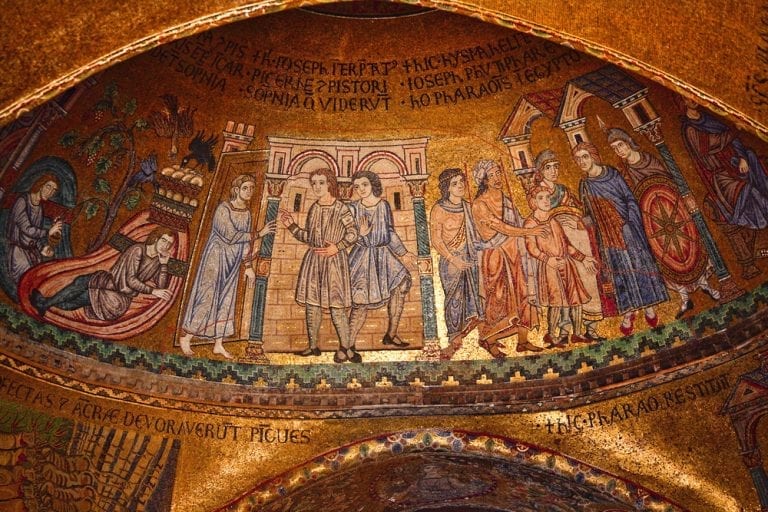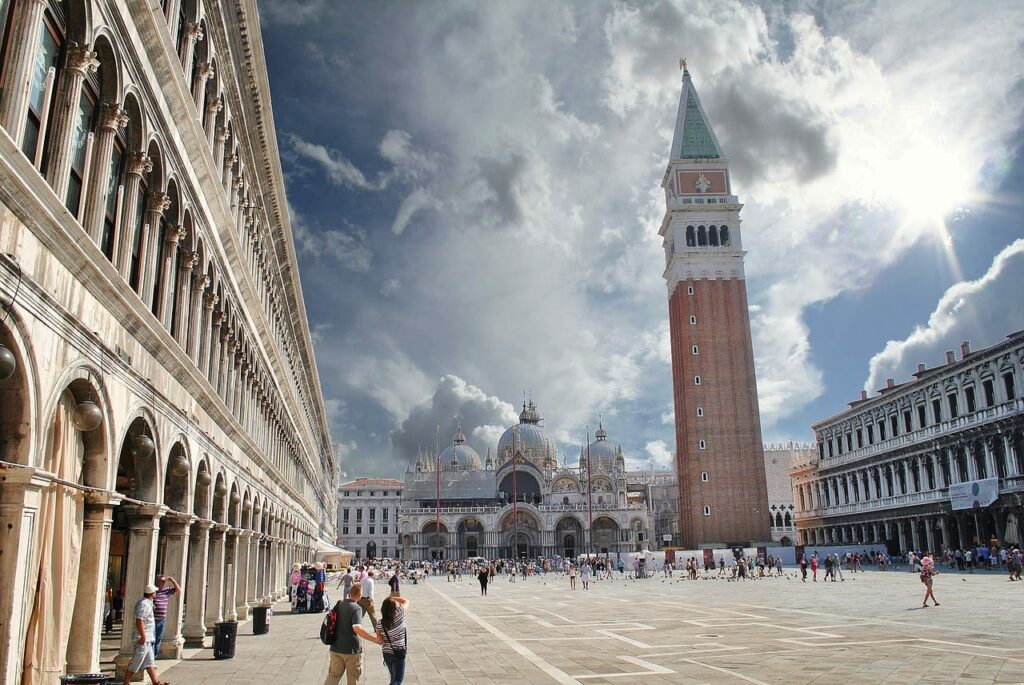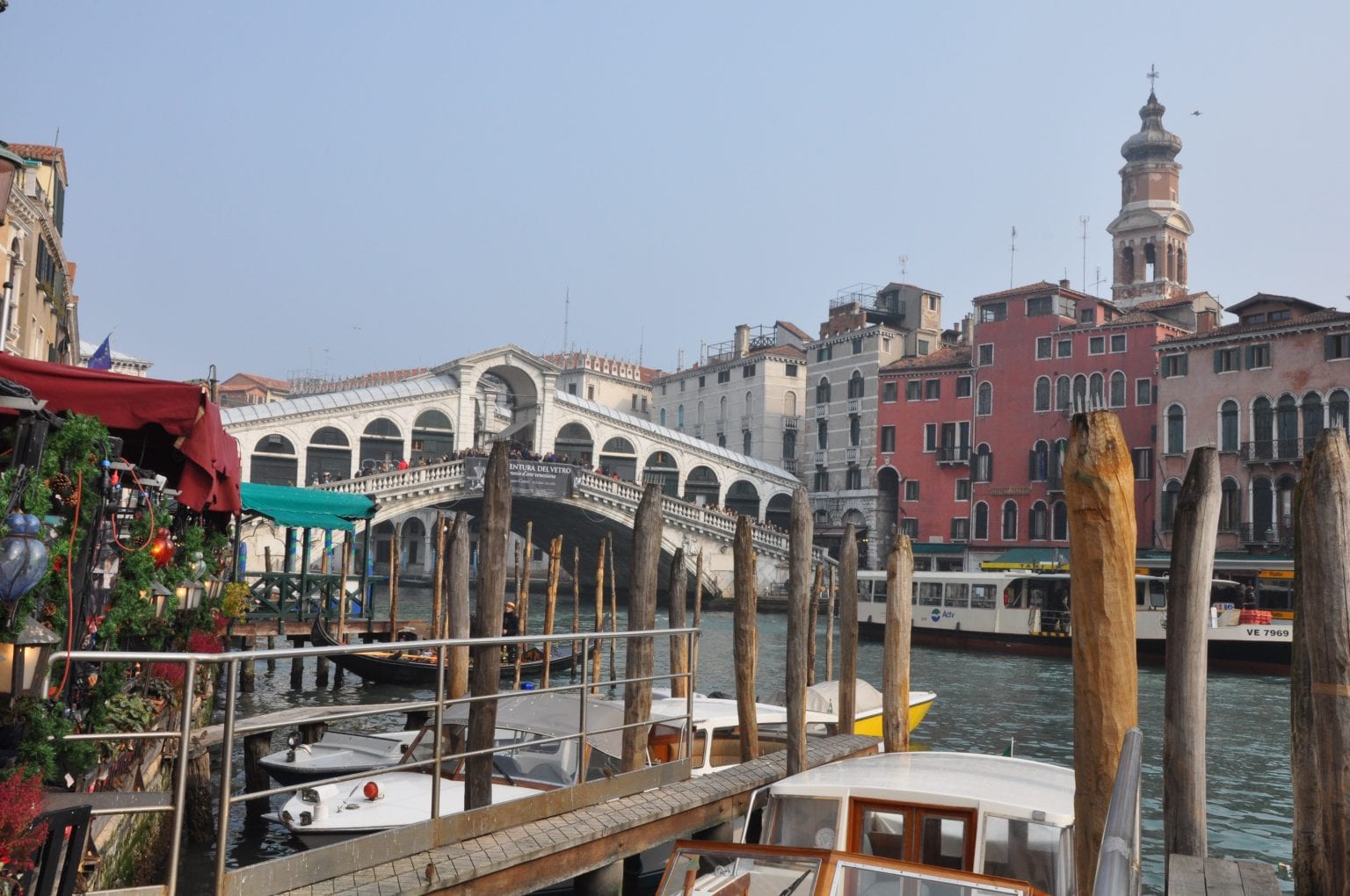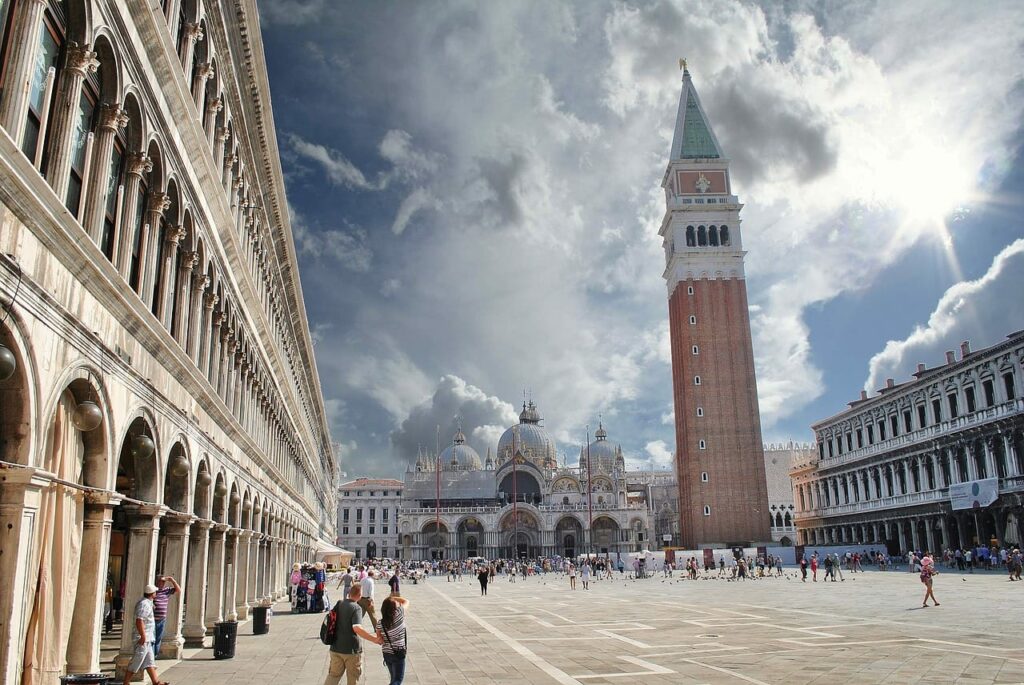המשך לחקור
ונציה, איטליה
חיוני ונציה
גלו עוד
בזיליקת סן מרקו היא אחד האתרים המתויירים ביותר בוונציה, וחובה לראות במסלול איטליה של כל מטייל! אבל עם היסטוריה המשתרעת כל הדרך חזרה למאה ה -9 לספירה, זו גם כנסייה עם הרבה סיפורים ואגדות מעניינים מאחוריה. הנה שש מהעובדות המרתקות ביותר על בזיליקת סן מרקו!
1 הבזיליקה החלה עם סיפור סוחף של חטיפה
 הראשון בזיליקת סן מרקו נבנה במקום זה במאה ה -9 כדי לאכלס שרידים קדושים מאוד - שרידים שנגנבו! בשנת 828 גנבו סוחרים מוונציה את גופתו של מרקוס הקדוש האוונגליסט, אחד מארבעת השליחים, מאלכסנדריה, מצרים. על פי האגדה, הם הגניבו אותם על פני השומרים (המוסלמים) על ידי הסתרתם מתחת לשכבות של חזיר בחביות!
הראשון בזיליקת סן מרקו נבנה במקום זה במאה ה -9 כדי לאכלס שרידים קדושים מאוד - שרידים שנגנבו! בשנת 828 גנבו סוחרים מוונציה את גופתו של מרקוס הקדוש האוונגליסט, אחד מארבעת השליחים, מאלכסנדריה, מצרים. על פי האגדה, הם הגניבו אותם על פני השומרים (המוסלמים) על ידי הסתרתם מתחת לשכבות של חזיר בחביות!
בעוד בים, סערה כמעט הטביעה את שודדי הקברים ואת המטען היקר שלהם, הוא אמר כי מארק הקדוש עצמו הופיע לקפטן ואמר לו להוריד את המפרשים. הספינה ניצלה, והסוחרים אמרו שהם חייבים את ביטחונם לנס.
הסיפור כולו מצולם על הפסיפס מהמאה ה -13 מעל הדלת השמאלית כשנכנסים לבזיליקה.
2 יש מספיק פסיפס כדי לכסות 1.5 מגרשי כדורגל אמריקאים!
There are more than 85,000 square feet (or 8,000 square meters) of mosaic in St. Mark’s Basilica… or enough mosaic to cover over 1.5 American football fields! The mosaics were done over 8 centuries, mostly in gold, and the result is astonishing. Enter the basilica at different times of day to see how the light makes the colors and scenes, look different.


3 יש יותר מ-500 עמודות
רק דוגמה נוספת לגודל העצום, וכמות הדברים המדהימים, בבזיליקת סן מרקו הוא מספר העמודות. בבזיליקה יש יותר מ-500 עמודים ובירות, ורובם ביזנטיים, המתוארכים למאות ה-6 וה-11. כמה בירות קלאסיות מהמאה השלישית מעורבבות, מדי!

4 הרבה מאוצרות הבזיליקה הגיעו ממסעות הצלב ומקונסטנטינופול
מסע הצלב הרביעי, במיוחד, נתן לבזיליקת סן מרקו מציאה. אחרי הכל, זה היה מסע הצלב שהסתיים, בשנת 1204, עם כיבוש קונסטנטינופול (איסטנבול של ימינו).
The result? A lot of treasure was shipped to Venice, and installed in St. Mark’s Basilica — including the four bronze horses, an icon of the Madonna Nicopeia, enamels of the Golden Altar-piece, relics, crosses, chalices, and patens!

5 פאלה ד'אורו מבייש את תכשיטי הכתר
תשכחו מאבני החן הנוצצות במצודת לונדון: למשפחת המלוכה אין כלום בבזיליקת סן מרקו! פאלה ד'אורו, מסך מזבח ביזנטי של זהב, משובץ במאות אבני חן - פשוטו כמשמעו. הם כוללים 1,300 פנינים, 300 אבני ברקת, 300 ספירים, 400 גארנטים, 100 אמטיסט, בתוספת אבני אודם וטופזות.
6 מגדל הפעמונים הזה? הוא התמוטט פעם אחת.

קמפניל באורך 98.6 מטר של סנט מרקו מתוארך למאה ה-9. אבל זה היה צריך להיבנות מחדש בשנת 1903. מה הסיבה? היא התמוטטה! זה עובד מחדש במאה ה -16, וכנראה לא כל כך טוב.
היא התמוטטה ב-14 ביולי 1902. (למען ההגינות, הוא שרד כמה רעידות אדמה לפני כן!). למרות שהיא קברה את המרפסת של הבזיליקה בהריסות, למרבה המזל, הכנסייה עצמה ניצלה. אבל התקרית הייתה מביכה מספיק!
משנת 1903 עד 1912, מגדל הפעמונים נבנה מחדש בדיוק כפי שהיה... אלא עם טכניקות טובות ובטוחות יותר.
אוקי שהזכרנו שישה, אבל מאז אנחנו על הגל, הנה תובנות מרתקות יותר:
- חתיכות הזהב של הפסיפסים בתוך בזיליקת סן מרקו עשויות מזהב אמיתי!
Venice was in the past a very wealthy city of merchants: what the Republic lacked in military strength or in land domination, it had in riches. The basilica’s mosaics are not just a way to please God and St. Mark or to communicate complex religious concepts, they were also a way to show the wealth of the city to important guests, like kings or ambassadors from other countries.
חתיכות הזהב עשויות למעשה מזהב: לכל אחת מהן יש עלה זהב דק 'סנדוויץ' בין שתי שכבות של זכוכית שקופה. עם תצוגה כזו של חומר יקר, הוונציאנים יכלו להראות בו זמנית את מסירותם הגדולה אך גם את 'משקלם' הפוליטי: דבר חשוב ביותר למדינה כה קטנה.
- הכיפות החיצוניות הגדולות מעל הבזיליקה הן למעשה מזויפות!
In Venice, it’s impossible to build huge structures: the terrain is frail, so you have to carefully stick to small, light and flexible buildings. But the Venetians had to find a way to astonish their guests: so they optimized some very clever tricks to cheat the eye and give everyone the impression that the buildings are huge and imposing.
In St. Mark’s Basilica, there is a great example of this: the five big domes that give the building its distinctive shape are just a superstructure made of wood covered with a thin layer of lead. They are actually completely empty: the brick-built domes with the mosaics that you see inside the church are much lower.
We can arguably say that the only role of those big empty domes is to make the building look much bigger than it really is: this way the ships approaching the city could recognize its shape from afar, and be even more astonished by the legendary city rising from the waters.
- בשנת 2019, "אקווה אלטה" גדולה הציפה לחלוטין את הכנסייה!
In the Venetian Lagoon, there are tides: sometimes these tides go higher than normal and as a result, some parts of the city get flooded. St. Mark’s Square is the lowest part of the city, so it’s pretty common to see its floor partially or totally submerged in water.
But on November 12, 2019, things went completely out of control: the tide rose so high that it reached the second-highest level ever recorded in the history of the city. The custodians of the church were unprepared for this event: the water not only flooded the antechamber of the basilica, which is at the same level as the square but also the church itself, which is much higher.
The damage was substantial and the building is still recovering: at least this tragic event gave a big push to the completion of the MOSE project, a system of mobile barriers meant to protect the Lagoon from the most dangerous tides. The barriers were tested a couple of times in 2020 and apparently, they worked fine: we all hope they will be able to protect the basilica in the future.
- בזיליקת סן מרקו אינה העתיקה ביותר, ולא הכנסייה הגדולה ביותר בוונציה!
The St. Mark’s Basilica was built starting from the IX century: but the history of Venice starts way before that moment, in the V-VI century. So there are churches around the city that predate the most important monument: according to historians, the oldest holy building of the city could be the church of San Giacometto, very close to the Rialto bridge. The Rialto area was, in fact, the first spot that was colonized when the islands started to be populated: the city of Venice was actually called “Rialto” for the first centuries.
Despite its enormous size, at least in proportion with the other buildings of the city, St. Mark’s Basilica is also not the biggest church: this title goes to the church of Santi Giovanni e Paolo, home to the very powerful Dominican monastic order. Their monastery was so big that when Napoleon conquered Venice he chose that building to become the first big public hospital in the city: and the hospital is there still today! You can learn more about San Giacometto and Santi Giovanni e Paolo if you take the Welcome to Venice tour or the Venice in a Day tour, which both feature these very important churches!

Special thanks go to our Walks of Italy guide Mosè Viero for sharing these additional interesting facts about St. Mark’s Basilica.
אם אתה רוצה ללמוד עוד, בדוק את החוויות שלנו בוונציה של בזיליקת סן מרקו וארמון הדוג'ה - או, לביקור VIP אמיתי, גש לבזיליקת סן מרקו לאחר שעות העבודה, כאשר היא סגורה לציבור!
המשך לחקור
ונציה, איטליה
חיוני ונציה
גלו עוד

